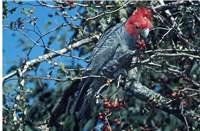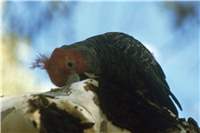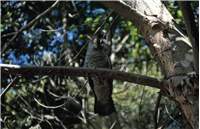Family
Cacatuidae
Genus
Callocephalon
Species
fimbriatum
Threats/Control Methods - Regional
Loss of nesting hollows poses a significant threat to the successful breeding of Gang-gang Cockatoos. These losses occur through land clearing, frequent fires and habitat degradation. Competition for the diminishing nest hollows occurs with other birds, such as the Common Myna (Acridotheres tristis ) and the Common Starling (Sturnus vulgaris ), and the Brush-tailed possum (Trichosurus vulpecular).
The Gang Gang Cockatoo is also susceptible to the Psittacine circovirus disease (PCD) which causes feather, beak and skin abnormalities. This disease is often fatal and is a contributing factor to the decline of populations across NSW.
Threats/Control Methods - Local
Free roaming domestic pets will attack young birds in their first few months of life.
Local/Urban Actions
Several actions can help to protect the Gang-gang Cockatoo from decline. The protection of remnant vegetation containing dead and mature trees is essential for protecting cockatoo populations. A vertical nest box at least 10m above the ground can also provide good breeding shelter. An entrance diameter of 12cm and an inside diameter of 22cm is recommended. Cat owners can prevent their pets preying on the species by installing a cat run or enclosure.
Common Names
Gang-gang, Gang-gang CockatooRed-crowned Cockatoo, Redheaded Cockatoo, Helmeted Cockatoo, Red-crowned Parrot and Redheaded Parrot.
Distinguishing Features
Both male and female Gang-gang Cockatoos have large pale grey bills, broad wings edged in white and a short tail. Adults range in size from 33 to 36 cm. They are predominantly grey bodied with a fine and wispy crest. Males have a bright orange-red crest and head while females have a dark grey crest and head. The base of the tail is washed in yellow and the tail is unbarred and dark grey. The female has grey and salmon pink bars on its under belly and while the tail is also dark grey, the base has greenish-yellow bars. The young resemble the adult female with the exception of a red crest and crown on young males.
Survey Techniques
Visual identification and calls.
Species Call
An unmistakable and prolonged, rusty, gate-like screech. When feeding: a soft growling.
Similar Species
The Gang-gang Cockatoo is quite unique in appearance. The Galah (Eolophus roseicapilla) is classed in the same family and may look similar in flight, but can be recognised by its pink face and belly and pinkish-white crest, crown and forehead.
Distribution
Southeast Australia from eastern NSW to southern VIC. Gang Gangs regularly inhabit the inner suburbs of Canberra, particularly those near Lake Burley Griffin, Black Mountain, Aranda and Mount Ainsle. They are most frequently encountered along the Cotter, Gudgenby and Naas River.
Country of Origin
Australia
Conservation (Pet/Pest) Status - Regional
The Gang-gang Cockatoo is a protected native species in the ACT and are listed as a vulnerable species in NSW. Over the last 20 years, the overall reporting rate in NSW has dropped by 44%. Sightings in the urban Canberra have been slowly increasing over the last 20 years and population levels in the region are considered stable (COG).
Conservation (Pet/Pest) Status - National
Currently not listed as a threatened species under the EPBC Act 1999, however it is considered a Protected Native Animal.
LSCCES Population
Pairs and small flocks were recorded throughout the survey area with highest detection frequencies in suburban Turner, CSIRO, ANU and NMA.
Associated vegetation community
Gang-gang Cockatoos show seasonal migration. During the summer, they are prevalent in mountain woodlands containing eucalypts and acacias up to an altitude of 2000m. In winter, they are found in drier, more open woodlands and in urban areas.
Limiting Resources
Gang-gangs require old, hollow-bearing trees close to a permanent water supply.
Breeding
The breeding season of Gang-gang Cockatoos lasts from October to January. Both the male and female take turns to incubate a clutch of 2 to 3 eggs. Hatching occurs at 30 days and the young remain in the nest for about 8 weeks. Nests are built in tree hollows of tall trees close to permanent watercourses. Preferred hollows are fairly high and vertical or steeply sloping, lined with wood chips chewed from hollow walls.
Behaviour
Gang-gang Cockatoos are seen in pairs during the breeding season and in flocks of up to 100 at other times. Seasonal migration occurs in this species with populations peaking in Canberra suburbs from April to September. In summer, they migrate to the Brindabella ranges to breed. Their feeding behaviour is distinctive; bunches of seed pods or berries are held in the foot, then individually removed, split open and held pressed against the foot while the seeds are extracted. Gang-gang Cockatoos will return to the same tree or bush each day until the food supply is exhausted. Feeding is noisy due to the continual soft growl they produce and the cracking and dropping of eucalypt seedpods. They have an arboreal nature and will only come to the ground for water. Their flight is heavy, with slow, sweeping wing beats.
Functional Group
Food Species
They mainly feed on the seeds of native and introduced trees and shrubs, particularly seedpods from eucalypts and the green pods of acacias. Berries from firethorn (pyracanthas) and hawthorn (crateagus), nuts and fruits are also eaten. Insects and their larvae can be consumed, however in the suburbs of Canberra, they prefer to feed on the seeds of Roman pines (Cupressus sempervirens).
Predators
Cats (Felis catus) are predators of Gang-gang Cockatoos that venture into urban areas in the ACT.
Interesting Fact
Gang-gang Cockatoos have been observed lying on the ground, intoxicated from eating over-ripe and fermenting Hawthorn berries. They always use their left foot to hold food during feeding and they are the prime animal emblem of the ACT.
References - (reader suitability of references, P=Primary teachers, S=Secondary students, T=Tertiary students and researchers)
Books:Canberra Ornithologists Group. 2000. Birds of Canberra gardens. Canberra Ornithologists Group and Urban Services, ACT Government, Canberra. S, T
Delgale, J. 1997. Attracting Birds to your Garden in Australia. New Holland Publishing. NSW. P, S, T
Forshaw, J. 2002. Australian parrots. Alexander Editions. Robina. S, T
Morcomber, M. 2000. Field guide to Australian Birds. Steve Parish Publishing. Archerfield. P, S, T
Pizzey, G. 2000. The Graham Pizzey & Frank Knight Field Guide to the Birds of Australia. Angus & Robertson, Sydney. P, S, T
Taylor, M. 1992. Birds of the Australian Capital Territory: an atlas. Canberra Ornithologists Group and National Capital Planning Authority, Canberra. S, T
Veerman, P. 2003. Canberra birds: a report on the first 21 years of the garden bird survery. Canberra Ornithological Group, Canberra. S, T
Online Publications:Australian Museum. 2005. Gang-gang Cockatoo (Callocephalon fimbriatum) Fact sheet. [online]. Available at: http://www.birdsinbackyards.net/finder/display.cfm?id=102 P, S, T
Department of Environment and Conservation (NSW). 2005. Gang-gang Cockatoo - profile. [online]. Available at: http://www.threatenedspecies.environment.nsw.gov.au/tsprofile/profile.aspx?id=10975 S, T
Department of Environment and Heritage, ACT Government. 2004. Beak and feather disease (psittacine circoviral disease). [online]. Available at: http://www.deh.gov.au/biodiversity/invasive/publications/p-c-disease/index.html S, T
Department of Environment and Heritage, Australian Government. 2006. Threatened species and threatened ecological communities. [online]. Available at: http://www.deh.gov.au/biodiversity/threatened/species/index.html S, T
Environment ACT, ACT Government. 2006. Protected Native Birds. [online]. Available at:http://www.environment.act.gov.au/petsandlocalwildlife/birds P, S, T
Environment ACT, ACT Government. 2006. Listing of Threatened Species, Ecological Communities and Threatening Processes. [online]. Available at: http://www.environment.act.gov.au/nativeplantsandanimals/threatecspec/thrtspecinfo S, T
National Parkes and Wildlife Service NSW. 1999. Natural tree hollows: essential for wildlife. [online]. Available at: http://www.nationalparks.nsw.gov.au/PDFs/Factsheet5_Tree_Hollows.pdf#search=%22eucalypt%20hollow%20years%22 P, S, T
NSW National Parks and Wildlife Service. 2005. Gang-gang cockatoo - vulnerable species listing. [online]. Available at: http://www.nationalparks.nsw.gov.au/npws.nsf/content/gang-gang_cockatoo_vulnerable S, T
Pyle, J. 2006. The Gang Gang Cockatoo. [online]. Available at: http://www.birdkeepinginaustralia.com/memberssection/articles/article25.pdf S, T



 Top
Top Top
Top